
Are you looking for the perfect foreground plant for your aquarium? The Dwarf Water Trumpet, or Cryptocoryne Parva, might just fit the bill. The Cryptocoryne Parva, one of the smallest of the crypt aquatic plants, is a hardy, albeit slow-growing, species that eventually blankets your tank.
With little effort and a little time, you’ll find that the Crypt Parva is a lush addition to your aquarium and it’s easy to maintain.
Cryptocoryne Parva Facts & Overview
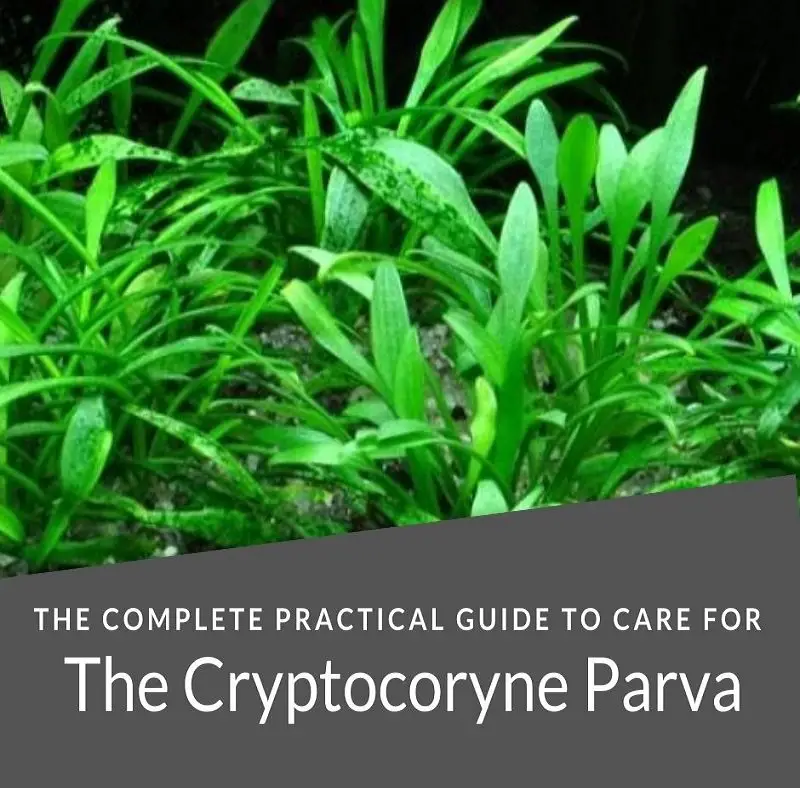
| Category | Rating |
| Care Level: | Easy |
| Lighting: | Low to medium |
| Color Form: | Green |
| Origin: | Sri Lanka |
| Height: | 2-4 inches (5-10 cm) |
| Diet: | Fertilizer |
| Family: | Araceae |
| Minimum Tank Size: | Any size |
| Tank Set-Up: | Freshwater, pH 6-7.5 |
| Growth Rate: | Slow |
This aquatic plant is native to the riverbanks of Sri Lanka. The Crypt Parva hails from Kandy, a large city located in the central province of Sri Lanka. Situated on a plateau that is surrounded by mountains, Kandy is known for its tea plantations and rainforest, which explains the positive conditions for Crypt Parva growth.
In this natural habitat, the Dwarf Water Trumpet sees dense growth due to the humidity and moist climate. Its full botanical name is Cryptocóryne párva de Wit.
In the past, some people confused Crypt Parva and the Cryptocoryne x willisii, and in fact, the name Cryptocoryne nevillii was used for both varieties; however, they are now understood to be completely separate species.
The Cryptocoryne x willisii, also called Willis’ Water Trumpet, is in the same family, Araceae, and looks similar, but has a shorter, egg-shaped leaf. It also grows much faster than the Crypt Parva.
The Cryptocoryne name comes from the Greek word crypto, which means hidden, and coryne, which means club.
Species History
In 1779, scientists described the first Cryptocoryne species, Arum spirale. It was not, however, until 1828 that Friedrich Ernst Ludwig von Fischer first described the genus.
There is confusion and dispute about the scientific classification of the Cryptocoryne species. The genus Cryptocoryne is closely related to the genus Lagenandra, though they are easily distinguishable by their distinct vernation or the arrangement of the leaves.
Appearance
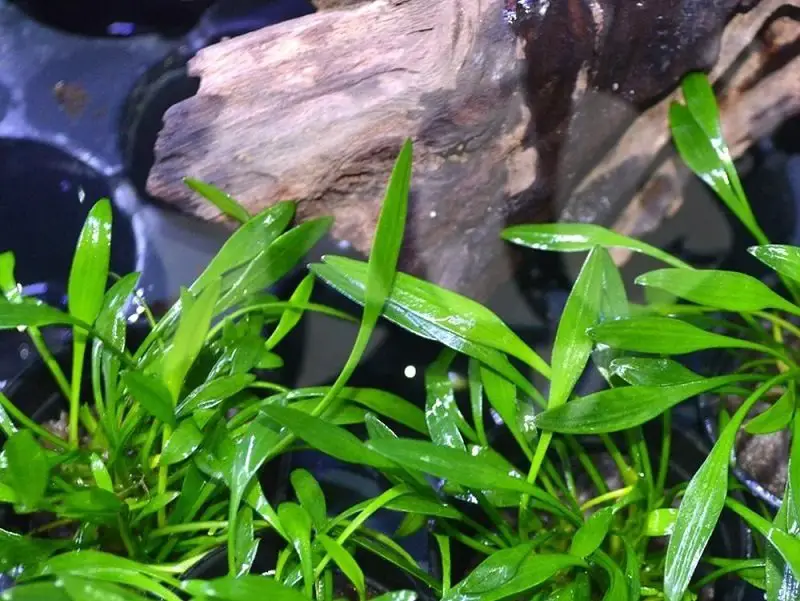
The Dwarf Water Trumpet, the smallest of the crypt species, grows to no more than 4 inches (10 cm) tall, and each stem is about 2 to 2.8 inches (5 to 7 cm) wide.
Its color and form are unchanging even in diverse habitats. However, the emersed leaves (above the water) are wider, and the submerged (underwater) are more narrow. These leaves are similar in appearance to grass, in both shape and color. They follow a rosette pattern, meaning all the leaves originate from a common stem.
Given time, these slow-growing dwarf plants will carpet your aquarium, and we recommend them for the front of your tank. It can also be used midground and as a bush. Because they’re so small, they are appropriate for your nano tank.
Optimal Growth
Although the Crypt Parva grows pretty easily and is not a problem to maintain, we have some tips to make sure your Dwarf Water Trumpet thrives and spreads. Always remember, too, that these plants grow slowly, so patience on your part is key.
Planting potted aquatic plants
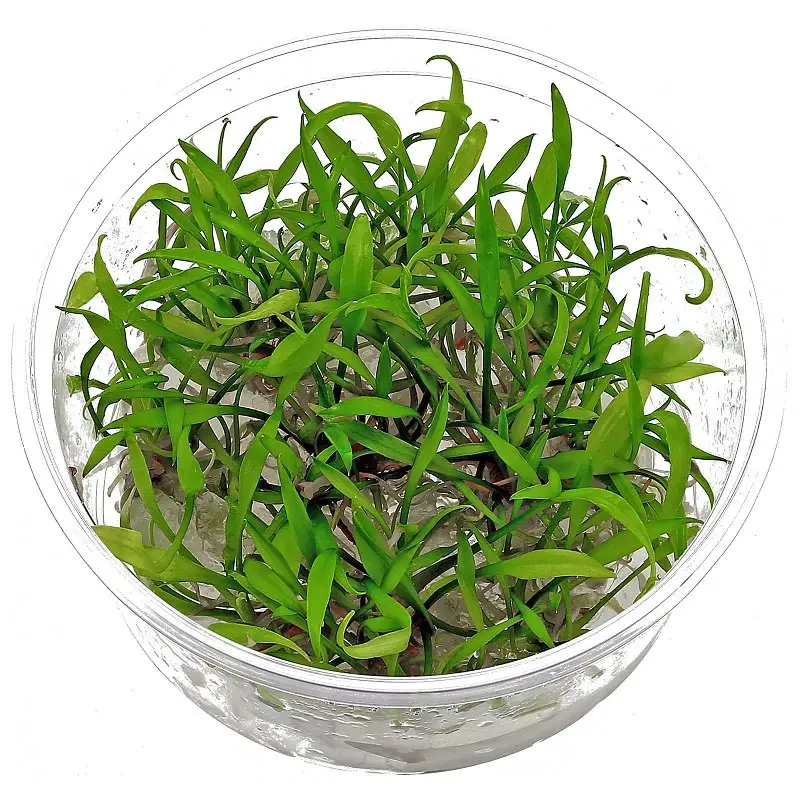
Usually, your Dwarf Water Trumpet arrives in a small clay (or plastic) pot. To protect the roots and incorporate a temporary substrate, it’s wrapped in cotton or wool, which will need to be removed.
Being mindful of the roots, remove the Crypt Parva from the cotton or wool and the pot.
Start by digging a small hole into the gravel substrate in your tank, and then insert the plant into the hole, and push gravel back around the entirety of the plant.
Pro tip: It is possible to place the plant with pot into the gravel substrate, but doing so can inhibit the optimal growth of the Dwarf Water Trumpet.
If you’re planting multiples, leave a few centimeters between each plant. Crypt Parva usually comes in pots with as many as 20 individual plants.
There is a possibility that your Dwarf Water Trumpet will come root only (rootstock), which means it will come with no leaves. That happens sometimes because you’re likely to lose the leaves anyway when you plant them (a phenomenon that is known as melt, which we’ll discuss later in this section.)
If your plant comes without leaves, don’t worry; new leaves will grow.
Tank Conditions
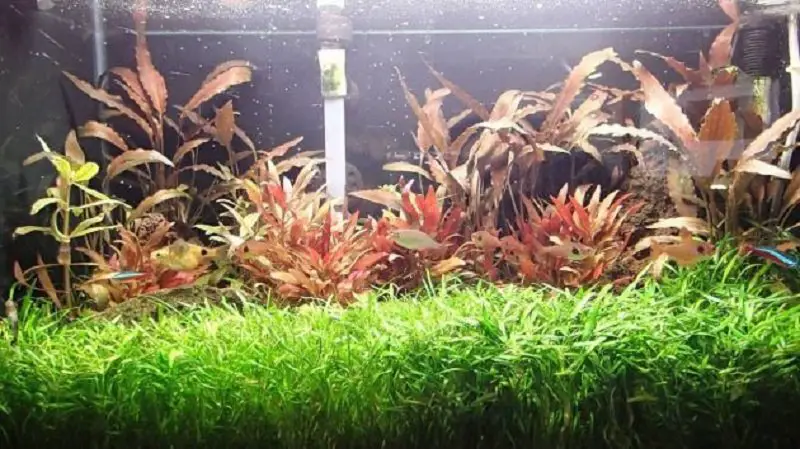
The Crypt Parva is not super fussy about its living conditions, but here are some specifications of its favorite circumstances. Although Co2 is not required for the Crypt Parva, adding Co2 will maximize growth.
Lighting
Other varieties of Crypts require only low light, yet the Crypt Parva prefers moderate light. This preference may result from its smaller size, resulting in a greater distance between the light source and the plant, or perhaps because taller plants in the tank block their access to the light.
The Crypt Parva will grow in low light, but it will lengthen the already slow growth.
Water Parameters
The Crypt Parva experiences optimum growth in warmer water (think back to its natural habitat in humid Sri Lanka.)
These tiny aquatic plants prefer temperatures in the range of 68° to 84°F or 20° to 29°C. The pH range should be between 5 and 8. Carbonate hardness should be 1 to 18 dKH (degree of carbonate hardness), and general hardness should be 0 to 30 dGH (degree of general hardness).
Full water specifications:
- Carbonate Hardness: 1 – 18 dKH
- Carbon Dioxide: 5 – 40 mg/l
- Iron: 0.01 – 0.5 mg/l
- Nitrate: 10 – 50 mg/l
- pH: 5 – 8
- Phosphate: 0.1 – 3 mg/liter
- Potassium: 5 – 30 mg/liter
- Temperature 15 – 28° C
Tank Size
The Dwarf Water Trumpet is quite small, so there is no minimum tank size. You could grow Crypt Parva in a larger tank, too, although it might not be as visible until propagation has occurred and the plant has blanketed the foreground of your aquarium.
Crypt Melt
Crypt Melt is one of the most common situations we hear about when aquarium enthusiasts plant new crypts in their aquarium community, and Crypt Parva is no exception. Some even refer to Crypt Melt as a disease.
Crypt Melt essentially means all the leaves fall off the plant and die. This phenomenon may be due to the change in the plant’s habitat. Adapting to new environments is difficult for most of us, right?
It will take about a month for the Dwarf Water Trumpet to feel comfortable in its new home, at which point, growth of new leaves will commence. You can remove decaying leaves or let the scavengers in the tank feast on them.
Pro tip: Some hobbyists recommend waiting to plant Crypt Parva until after your aquarium community has been established for at least 3 months.
It is possible to grow Dwarf Water Trumpets above the water surface (emersion); some believe that the switch from above water to underwater can cause the melt. Once 2 or 3 submerged leaves sprout, you will likely see some melt.
Note: In their natural habitat, the Crypt Parva grows fully submerged.
Some aquarium enthusiasts maintain that nitrate buildup can cause melt, and recommend changing the tank water on a regular basis.
Care
It’s best to avoid replanting your Crypt Parva once it is situated. As we mentioned before, they have a low tolerance for change. Also remember that since they grow horizontally via their rhizomes, transplantation would be a major undertaking.
Once they are planted in your substrate (some hobbyists prefer gravel or sand, while others lobby for dirt), you can nourish them with fertilizer. If you’re using gravel or sand, you can try fertilizer tablets. If you’re using dirt, you could choose soil that is already fortified with nutrients. As we mentioned before, Co2 can also be added.
Pro Tip: Remember that if you add more nutrients to maximize growth, you may also have to do more pruning of your Dwarf Water Trumpets.
Additionally, Crypt Parva plants need higher levels of iron and potassium. Keeping these levels within the recommended parameters (see the above section on tank conditions) will prevent the leaves from getting holes.
Risk of chlorosis, a condition in which a plant’s leaves yellow due to lack of chlorophyll, is another reason it’s vital to maintain proper tank conditions. Iron deficiency is one cause of chlorosis, and even an off-kilter pH level can cause trouble for these plants.
Green Spot Algae
One final malady that can afflict Crypt Parvas is green spot algae. Green spot algae primarily grow on inanimate objects in your tank, but it also grows on slow-growing plants like our Crypt Parvas.
If you keep the circulation moving at a sufficient level, you should be able to prevent the green spot algae. Other causes of green spot algae are low phosphate levels and too much light.
And since you’ll be tending to your tank regularly, if you spot any green spot algae, you should be able to remove it before it harms the plants. You can remove green spot algae by adding some Zebra Nerite Snails, who will gladly eat the green spot algae, or scrape it off yourself.
The latter might be a better option if you’re hoping to get the algae off the plants. Snail-eating algae off the tank glass or a rock would be preferable to it nibbling on a live plant.
To ensure maximum health in your Crypt Parva plants, regularly trim any leaves near the root that look like they are decaying or growing too much.
Tank Mates
Because the root systems of the Crypt Parva are so evolved, it would be difficult for fish or other aquarium residents to uproot it. Fry fish, dwarf shrimp, dwarf crayfish, and shy fish that like to hide will enjoy the lush leaves of the Dwarf Water Trumpets.
Goldfish, Koi, and cichlids may enjoy your Crypt Parva, but the feeling is not mutual; they could be nibbled to death by these herbivores.
Safe tankmates
- Barbs
- Danios
- Discus fish
- Gouramis
- Killifish
- Livebearers
- Rainbowfish
- Tetras (except Buenos Aires Tetras)
Not so safe tankmates
If you are looking for a super lush blanket in your aquarium, try pairing the Crypt Parva with Anubias or Lobelia Cardinali’s plants.
Propagation
Rhizomes
The Cryptocoryne Parva’s main method of propagation is through rhizomes. Rhizome is the term for a plant stem that has nodes that send out shoots and roots. Sometimes these rhizomes are called root stalks.
The root stalks (sometimes also referred to as creeping root stalks) grow horizontally out of axillary buds. Shoots may also grow upwards.
Runners
Another method of propagation is through runners, which are stems that grow at the surface of the soil surface or just below. In contrast, the rhizome is a root-like stem that can also grow underground, and as we mentioned, can grow horizontally.
Splitting
While rhizomes and runners are natural propagation methods, splitting is an artificial method in which the aquarium enthusiast takes a cutting from the top stem, just above a leaf node. They then rid the node of any leaves and plant the cutting in the substrate, following the instructions in the earlier section of this guide
Is Cryptocoryne Parva a Good Fit for Your Aquarium?
Crypt Parva is a nice addition to aquariums of any size. They require a modicum of attention and an abundance of patience, but caring for them is not super difficult; even beginner hobbyists will be able to optimize the growth and distribution of these Dwarf Water Trumpets.
One added bonus is that because these come potted if you had to dismantle your tank temporarily, you could foreseeably repot the Crypt Parva until you were ready to add it to your aquarium. It will also keep in the pot while you’re waiting for the requisite 3 months to establish your tank before adding these aquatic plants.
They get along with most other plants and aquarium residents, so they’re a good choice for many aquarium communities.
Do you have any questions about planting or growing Cryptocoryne Parva in your aquarium? Ask your question in the comments below and we’ll do our best to answer it!

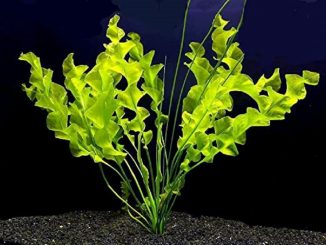
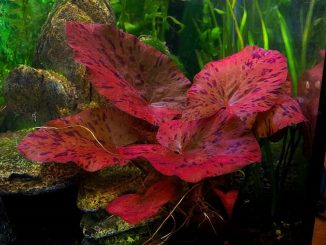
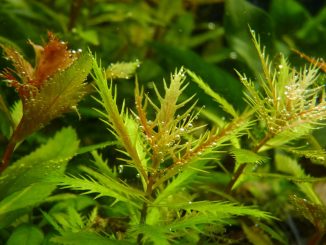
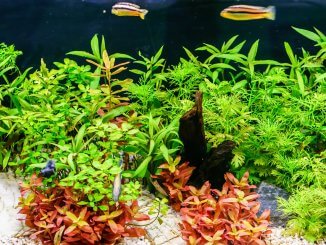
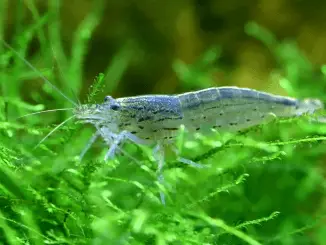
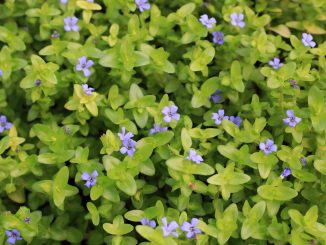
Be the first to comment